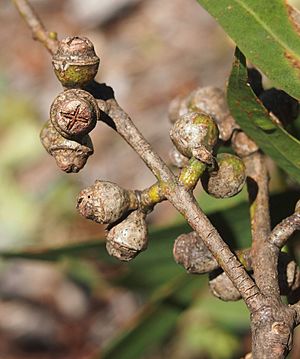Queensland peppermint facts for kids
Quick facts for kids Queensland peppermint |
|
|---|---|
 |
|
| Eucalyptus exserta growing near Gogango, Queensland | |
| Scientific classification | |
| Genus: |
Eucalyptus
|
| Species: |
exserta
|
| Synonyms | |
|
|
The Queensland peppermint (scientific name: Eucalyptus exserta) is a special tree or shrub found only in eastern Australia. It is also known by names like peppermint, bendo, yellow messmate, or just messmate. This plant has tough, stringy bark and long, thin adult leaves. Its flowers are white and grow in groups of seven. After flowering, it produces round or cup-shaped fruits.
Contents
What is the Queensland Peppermint?
The Queensland peppermint can grow in two main ways. It can be a small, bushy shrub called a mallee, reaching about 5 meters (16 feet) tall. Or, it can grow into a tall tree, up to 20 meters (66 feet) high. This plant has a special woody swelling at its base called a lignotuber. This helps it regrow after fires or damage.
Bark, Leaves, and Flowers
The bark of the Queensland peppermint is usually grey. It is hard, rough, and has deep cracks, feeling very fibrous. This bark covers the trunk and even the smaller branches.
Its adult leaves are a bit shiny or dull green. They are shaped like a spear, between 6.5 and 18 centimeters (2.5 to 7 inches) long. They are also 0.7 to 2.7 centimeters (0.3 to 1 inch) wide. These leaves grow on a small stem called a petiole, which is about 0.8 to 2 centimeters (0.3 to 0.8 inches) long.
The flower buds grow in groups of seven. They are found where the leaves meet the stem. Each group of buds sits on a stalk called a peduncle, which is 0.6 to 2 centimeters (0.2 to 0.8 inches) long. The individual buds are oval-shaped, about 0.7 to 1.1 centimeters (0.3 to 0.4 inches) long. They have a cone-shaped cap. You can see these white flowers in January, May, and December.
Fruit and Seeds
After the flowers bloom, the plant produces woody fruits. These fruits are called capsules. They are shaped like a half-sphere or a cup. Each capsule is about 0.2 to 0.7 centimeters (0.08 to 0.3 inches) long and 0.4 to 0.8 centimeters (0.16 to 0.3 inches) wide. The capsules have a raised center and valves that stick out. These valves open to release the tiny seeds.
History and Naming of the Queensland Peppermint
The Queensland peppermint was first officially described in 1859. A botanist named Ferdinand von Mueller gave it its scientific name, Eucalyptus exserta. He published his description in a science journal. The word exserta comes from a Latin word meaning "sticking out." This refers to the valves of the fruit, which stick out from the capsule.
Where Does the Queensland Peppermint Grow?
This plant is found in many parts of central, southern, and eastern Queensland, Australia. It grows from the Charleville area all the way to the coast. It also extends north to Mareeba. You can also find a small number of these trees in northern New South Wales, in a place called Bebo State Forest.
E. exserta likes to grow on rocky hills and rises. It prefers sandy soils that are not very fertile. It is often found in dry sclerophyll woodlands. These are forests with tough, dry-leafed plants.
Ecology and Wildlife Connections
The Queensland peppermint plays an important role in its environment. It acts as a host tree for several types of mistletoe. Mistletoe is a plant that grows on other plants. The mistletoe species that grow on E. exserta include Amyema miquelii, Dendrophthoe glabrescens, and Dendrophthoe homoplastica.
The leaves of the Queensland peppermint are also a food source for koalas. Koalas are famous Australian animals that eat mostly eucalyptus leaves.
Uses and Cultivation
The Queensland peppermint produces many flowers. This makes it important for honeybees, as it provides them with a lot of food. Farmers sometimes plant E. exserta on their land. It can provide shade for animals or act as a windbreak. It grows best in soils that drain water well.
In the 1960s, plantations of E. exserta were started in Guangdong Province, China. These trees were planted to help stop soil erosion. This means they helped keep the soil from washing away.



